Debian Upgrade Marathon: 3.1 Sarge
Apr. 25, 2025 [Technology] [Hardware] [History] [Introspective] [Libre]Had my priorities been better aligned, I would have first begun building Linux skills sometime during the Bush (W) administration. It has left me feeling as though I should make up for that lost time. So I’ve decided to reclaim that lost experience of installing and using Debian from around the early-mid 2000s. From there, the plan is to upgrade the installation through each stable release up to present day Debian Stable. And hopefully pick up a few tricks along the way. Or at least earn my rite of passage as a bonafide Debian historian.
It is most appropriate that I begin with Debian 3.1 Sarge. Not only because that was the active release around the time I first tried tinkering (and failing) with Linux install media. It is also an appropriate launch point simply because I am no longer in possession of any motherboards predating 2004. And, no, doing this kind of exercise within virtual machines just isn’t the same.
This marathon will be taking reprieves at each release for excursions along the way. Not least of which to test out file compatibility, media playback, web browsing and just absorbing the overall vibes.
Start
The starting machine needed to match as closely as possible the first PC I ever had. I have a suitable socket 478 board, with only about a 1GB of SDRAM installed. We’re going to try to use the glorious Intel integrated “eXtreme” graphics.
It was badly in need of a thorough cleaning and the power supply tested bad. I may have bent a few pins on the Pentium 4 but it was worth setting it up nice and happy with a new heatsink fan. This board is old enough that it cannot use USB flash storage as a boot device, necessitating the use optical discs!
All available PATA optical drives on hand were K.I.A. so I needed to resort to a PATA-SATA converter to use a newer working optical drive. This also made possible the use of a SATA hard drive right from the start, so we get to cheat a little.
I found that the Sarge 3.1 installer would cause the board to reboot back into self-test and POST. The workaround was to launch the installer with linux acpi=off arguments.
The contemporary Debian installer has seen much refinement since its earliest versions, having made its first appearance in Sarge. This original installer waits until after you’ve booted your freshly written Debain before walking through user and config setup, which I found odd.
Debian Sarge also insists that a root password must be created. The option to leave it blank to automatically disable root login must have been added later in the project’s history. Because of this, the standard user that you later setup is not automatically added to the sudoers file, and must be added manually.
Now, because the Sarge repositories have long since been archived, I need to manually point apt sources to the archive repository:
deb http://archive.debian.org/debian/ sarge main contrib
deb http://archive.debian.org/debian-archive/debian-security/ sarge/updates main contrib
And also had to manually disable the Debian CD entry.
The integrated graphics chip for this board is Intel i800 family, so I selected the i810 driver when configuring “desired X server driver”.
The installer asks about setting up the mouse, which perhaps would have made sense in the days of serial port mice. I simply went with the default /dev/mouse option and the USB mouse (manufactured long after 2005) worked just fine.
Gnome login appears to use some kind of visual loading bar but with an SSD it goes by so fast I can’t really see what it is trying to indicate. Did I mention how fast these old single core Pentium systems can feel with solid state storage and fiber connectivity?
Impressions of Sarge
Gnome DE 2.8 (Version 64 according to the package manager) feels very much like LXDE in its menu structure, modularity and snappiness. The thing looks like an interface from the early 00s, perhaps even the late 90s. I appreciate it as a time capsule, but probably would have found it an obstacle to endure had I been using Debian back in the day.
Theming options has the “Gorilla” GTK theme which I find to be so very archetypically 00’s in its aesthetics. A shame that we don’t build UIs to look like that today.
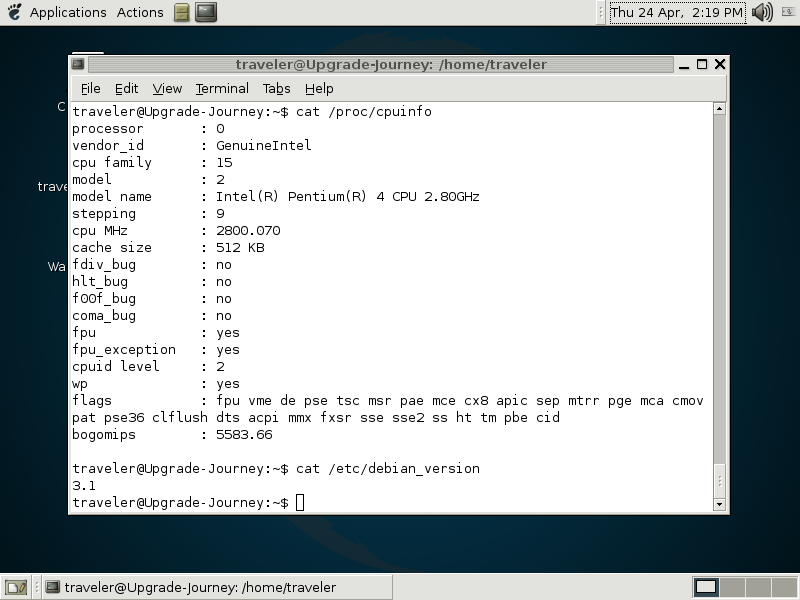
Vintage Gnome, in all its glory.
I see that the Debian desktop environment metapackage even back then supplies a bunch of default programs including some familiar and unfamiliar today; Synaptic, Eye of Gnome, GIMP, Inkscape, file-roller, OpenOffice and several dozen casual games. Debian gets points for consistency.
I was rather surprised to see several familiar programs had existed as far back as 2005.
Surprise cameos:
- ffmpeg
- clamav
- chkrootkit
- anthy
- blender
- cryptsetup
- moc
- flightgear
- git
In fact, git is 20 years old as of this month! I went ahead and installed most of them to make the place feel a little less alien. The apt command hadn’t been introduced yet so cli package management needs to be handled specifically through apt-get:
sudo apt-get install ffmpeg mozilla-firefox lynx chkrootkit vlc evince clamav moc rsync lm-sensors, xfonts-intl-japanese
Which fixed names of some test files that I copied to the drive. Gnome 2.8 apparently needs you to log out and back in for newly installed program shortcuts to appear in Gnome menus.
The mozilla-firefox package (v1.0!) is a separate web browser package from mozilla. It even has rudimentary extension support. AskJeeves is one of the default search engine options in Mozilla. That’s a real throwback! And Mozilla had supported SOCKS proxying as far back as 2005. In fact, their proxy settings page has hardly changed since then. Neat.
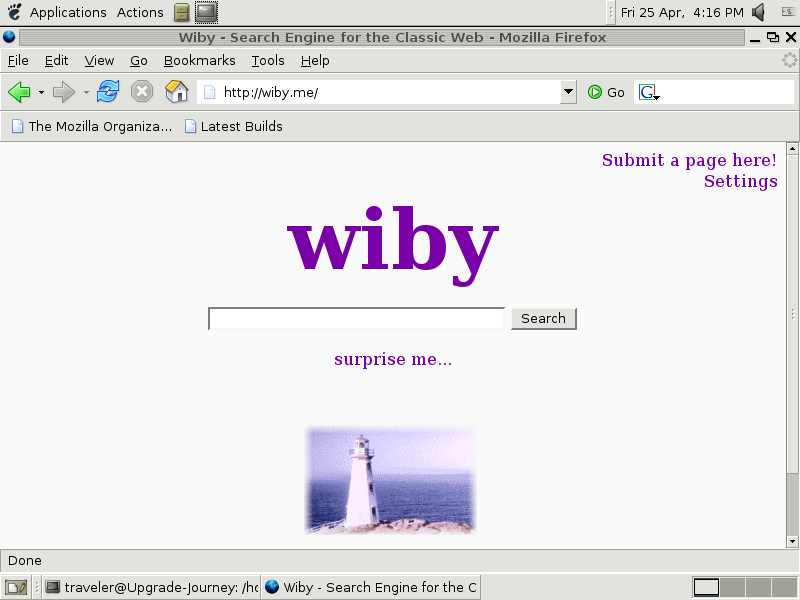
It can be seen where priorities were very different back then. The Mozilla web browser had a big “Print page” button along the top bar. And a toggle icon at the bottom for disconnecting from the web (taking Mozilla browser offline). The about:config settings page is a thing in old Mozilla, and some settings were still pointing to netscape.com as of Mozilla 1.7.8, exposing its true heritage.
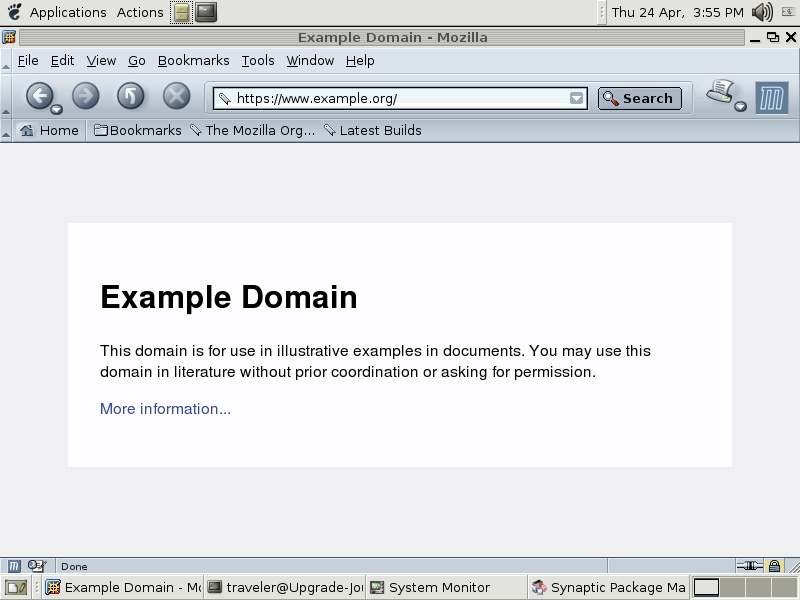
Only certain sites that negotiate very old SSL cipher sets can be loaded over HTTPS
I devised a few files to test on each version of Debian.
| Filetype | Functionality | Notes |
|---|---|---|
| Plaintext | ✔ | gedit 2.8.3 |
| ODT Document | 🗷 | Openoffice 1.1 (Test document created in LibreOffice 7.4) |
| PNG image | ✔ | Eye of Gnome 2.8.2 |
| Animated GIF | 🗷 | Eye of Gnome 2.8.2 |
| MP3 Audio | ? | Totem 0.100 (Decodes but no audio out) |
| OGG Audio | ? | Totem 0.100 (Decodes but no audio out) |
| MP4 Video | 🗷 | “codec ‘hev1’ not handled” Totem 0.100 |
| MP4 Video | 🗷 | “no suitable decoder module for fourcc ‘hev1’” VLC 0.8.2 |
| Webm Video | 🗷 | “no plugin to handle webm” Totem 0.100 |
| Webm Video | 🗷 | “no suitable module…” VLC 0.8.2 |
| Web | ? | “Mozilla and www.mozilla.org cannot communicate securely because they have no common encryption algorithms.” But other sites, such as www.example.org load and render okay. |
Okay, so file standards from the future cannot be read, big surprise. How about something a little more fun? 3D games? TuxKart:
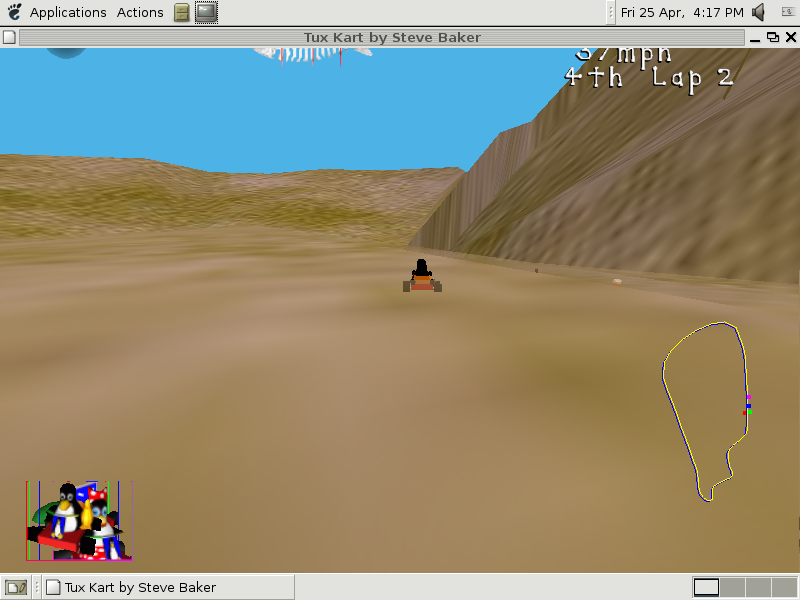
It runs. And it runs better than it probably had on real spinning platter machines from back in the day. But damn does vintage TuxKart feel like some individual’s home grown project. It’s kind of charming, actually. I can envision my younger self having tried Debian Sarge but probably later caving to the allure of games beckoning me back to XP. Or maybe the novelty of such an exotic system would have sustained my interest.
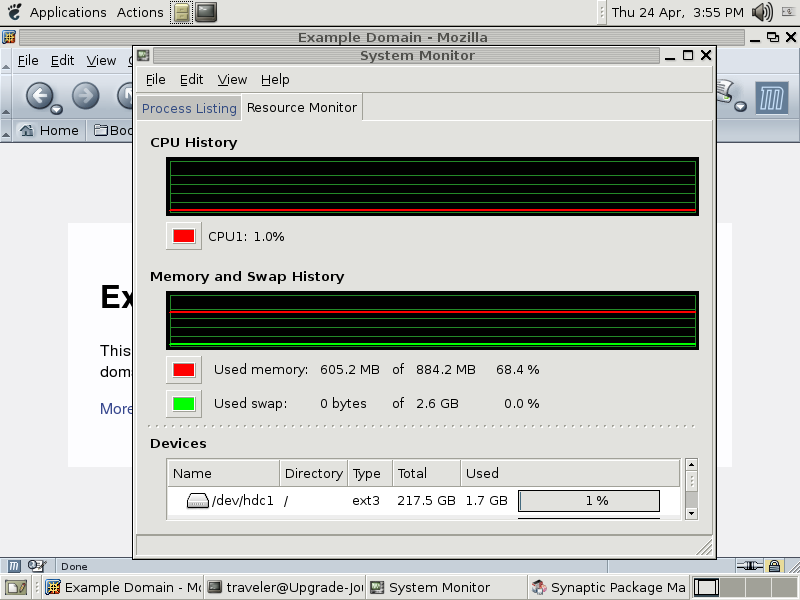
I wonder if this SSD being mapped 'hdX' is going to become a problem later...
Fun Factoids
Even though amd64 ISA hadn’t been a release target until Etch, Sarge had an amd64-libs package. Shared libraries for x86_64 systems.
glxinfo - Mesa 4.0.4 with OpenGL 1.2
The Adwaita icon set has hardly changed in the last twenty years!
aolserver package. Yes, that AOL.
PC speaker chirps on greeter login
Outstanding Issues
SSH
“Unable to negotiate with XX.XX.XX.XX port 22: no matching key exchange method found. Their offer: diffie-hellman-group-exchange-sha1,diffie-hellman-group1-sha1”
SHA1, yikes. I shortly disabled the ssh daemon, for that and for other reasons.
X Display Server
The X server on this installation cannot set the display to anything above 800x600 @ 73Hz so it doesn’t make use of the display’s 16:9 aspect ratio. But it works, with glxgears reporting a healthy 455 FPS and functional 3D animated screen savers. Those also take me back.
Networking
Despite being on a dual stack network, ifconfig reports the system only obtains IPv4 addressing.
But the focus of this undertaking is not on resolving issues in ancient Debian releases - back to upgrading!